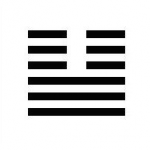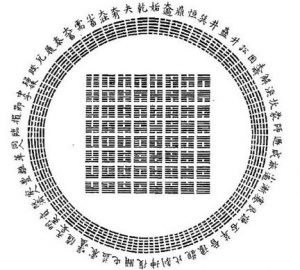64 Weeks

A personal journey into the nature of existence
The enigmatic Book of Changes has captured the imagination of philosophers, mystics, and governments for over 3000 years. With hundreds of interpretations and translations spanning centuries and continents, I decided to discover for myself what all the fuss is about.
It's been a long, a long time coming But I know a change gonna come, — Sam Cooke
I’ve been taking myself through an interesting experiment with the I Ching, the Book of Changes.
While legend has it that it was devised by the mythical culture-hero Fú Xī in the 3rd Millennium BCE, the earliest we can date the extant version is at least to the beginning of the Zhou Dynasty in the 1st Millennium (1046-221 BCE). This version was heavily edited and added to sometime after Confucius in the 5th century BCE, as it is considered that he provided further commentaries to the original Zhou text. It’s this version, supposedly handed down by that philosopher himself, that has continued to attract commentaries and interpretations through the centuries to the present day, where Western scholars have taken it and continued to provide alternative interpretations through multiple translations.
The text itself is considered to be a manual to understand divination practices in the early Zhou Dynasty, practices which evidence suggests were in practice in the preceding Shang dynasty. At its core, it is a set of 64 symbols made up of 6 lines, either solid or broken. The solid lines represent Heaven (yang), while the broken lines represent Earth (yin). This text is the foundation of Yin-yang theory, which emerged during the early Han dynasty sometimes during 1st – 2nd centuries BCE. The idea being that the universe is undergoing constant change (entropy) through the interplay of these two fundamental forces, Heaven and Earth.
The meanings come from the whole symbol (called a hexagram, a picture made from 6 lines), from the interpretation of the constituent halves (trigram, a picture made from 3 lines), as well as from the individual lines themselves, based on their position and how they relate to its surrounding lines.
On consulting the Book of Changes, one is meant to gain insight into the appropriate action to take (or not take) in any given moment. Essentially, the I Ching is a map into the algorithm of how things change in nature. Everything that exists in the universe is subject to the same laws, and is constantly changing from one state to another.
Time may change me But I can't trace time — David Bowie
“I’m going through changes”
This journey began rather unexpectedly on the Monday after the Winter Solstice in June. I woke up that morning and had the sudden inspiration to pick up one of the versions of the text I have (Hua-Ching Ni’s The Book of Changes and the Unchanging Truth). Whilst reading, I had the idea that in order to really understand the meanings behind each of the symbols, I could spend a week studying each of the hexagrams.
I would not only study the meaning of the hexagram, comparing the various translations I had, but I would attempt to embody the ideas into my normal daily routine. Each day I would read the Yao, the commentary on an individual line and use that as my morning meditation, also using time at the end of the day to reflect on my experiences and compare them to that line’s teaching.
And so I started that day with the first line of the first hexagram in the traditional sequence as presented in each book, said to have first been developed by King Wen, the progenitor of the Zhou dynasty.
As is usual, that moment I had the inspiration I immediately began imagining visions of writing a book, developing courses and workshops, and turning what had initially been a personal meditation journey and daily ritual into a grand project. I was immediately humbled when my first day’s teaching put me in my place:
潛龍勿用, Qián lóng wù yòng, 陽在下也。 yáng zài xià yěHere is was with grand visions, being inspired to take action on a new project, starting with the first yang line in the first yang hexagram… and I was being advised to wait, to not take any action. In that moment, I realised how many of my mistakes have come down to rushing into things. I put aside any preconceived notions of what this 64 week journey was going to be about, and began my meditation ritual.The dragon lying hidden in the deep is not time for taking action,
This comes from the yang line in the lowest place.
— my translation
Change is a powerful thing, People are powerful beings, Trying to find the power in me to be faithful — Lana Del Rey
It’s been 11 weeks now. I’ve been methodically sitting with the Book of Changes every day since that Monday. The project has evolved and changed over that time (of course), and now I spend each morning translating the text myself. My grasp of Mandarin is basic, however with a background in linguistics, and plenty of translations to help me learn the intricacies of grammar and syntax, I’ve been doing ok. I’ve also been learning Mandarin during this time, and I jokingly remark that I can read Chinese better than I can speak it.
There is always a moment each day where the wisdom of the hexagram, or that day’s Yao commentary, that influences my choices and actions. It’s been a remarkable tool to help me heal and re-emerge from my reclusive hibernation over the previous six months.
This week’s hexagram was particularly salient. In many ways it represents the essence of the I Ching’s teaching.
“Minor Earth, Major Sky”

Called 泰 TÀI, it describes a moment of peace and harmony where the primal forces of Yang and Yin come together in union. Peace ensues because Heaven and Earth express their unique (and polarised) nature authentically; and in their union, all within the world can progress and evolve naturally and in accordance with the laws of the universe.
It is this interplay of Yin-yang which makes all things come into being, and continue to transform through their inter-relationship. The ancient Chinese believed that humans were a microcosm of the universe at large, so what happens ‘out there’ in nature is reflected internally within ourselves, mirrored in our physiology (Earth, Yin) and consciousness (Heaven, Yang). Achieve tranquility within ourselves, and that will influenced the outside world with peaceful societies living in harmony with the laws of nature. And vice versa.
Time for a cool change — Little River Band
The 16th Century Taoist adept Liu Yi-Ming writes of this hexagram:
“If one is able to effect and preserve tranquility, why worry that one will not be fortunate and not develop, and not accomplish the Tao?” (Cleary 2003: 74).His words ring true to me. Given all my worries and anxieties, all my fears that I will never accomplish my goals, or that I’m not good enough to be the person I know I can be… if I am able to bring together Yang and Yin in harmony within myself, how can I not but be enough?
Mostly, my outer world is heavily influenced by the perceptual biases with which I look out onto it; I know that this is true. When I’m feeling shitty, life feels like a struggle; yet when I feel a deep inner peace, the world feels so much easier to walk through. Being able to recognise these two states, and how my perception of the world is affected by my internal states has been a marvellous gnosis.
This is the teaching of the first line: “once my inner demons are conquered, the outer demons will also submit” (Cleary 1994: 64). With the outer demons tamed, the inner demons cannot arise. In challenging situations, remaining true to my nature, my Values, and my integrity is what helps me get through. This is the overall teaching of the lower half of the hexagram, these 3 lines forming the image of Heaven.
Zhi-Xu Ou-Yi, a Buddhist scholar from the 16th Century, created a Buddhist commentary on the I Ching. His words on the meaning of the lines also give me an insight into the power of this text. The primal forces represented by the trigrams (and thus the larger hexagrams) are powerful states we can access to help us adapt to any and every situation that arises.
The wisdom contained in this text offer a level of guidance to dealing with mental and emotional angst without the need for drugs or herbs. I’m finding the psycho-mythological nature of the symbols deeply effective; probably why Arnold Mindell drew on this book in the development of Process-Oriented Psychotherapy.
Ou-Yi writes, “When one knows that demons have no reality, the demons become one’s assistants and are like neighbors [sic]” (Cleary 1994: 64). These ‘demons’ are but aspects of our psyche, signals from our Unconscious that we ignore at our own psychological peril. Enlightenment is not an escape to fairy-realm of unicorns and rainbows; it is understanding that the distinctions between ‘good and bad’ are illusory. Enlightenment exists at the level of ordinary existence; the sacred and the mundane are one and the same; heaven is earth.
They say in heaven, love comes first, We'll make heaven a place on earth — Belinda Carlisle
“Harmony”
After 11 weeks of this daily ritual, I feel I am coming to grips with various aspects of my life that I’ve been challenged with for some time. Mind you, I still have 53 weeks to go; I’m sure the exploration of life’s ups-and-downs using the I Ching as a map is going to reveal more and challenge me even greater.
For over twenty years I’ve been seeking deeper meaning and chasing spiritual enlightenment. In many ways I don’t feel I’m any closer; and yet, paradoxically, I feel so much wiser than I did in my twenties. Wise enough to realise the search didn’t need to happen, when I could have looked so much closer to home.
For many years I’ve been looking in the wrong places for the harmony I was craving; while I can find examples of peace ‘out there’, it’s only in making the connections with what I’m feeling internally that it makes a difference. I sit in wonder at how this has been part of the human condition for as long as we’ve been walking on two legs (probably). It’s why so many of us in the West have become fascinated with Buddhist philosophy, and the pragmatism of much of Eastern thought.
People want peace, A simple release from their suffering. — Paul McCartney

Photo by Colton Duke on Unsplash
I’ve also come to realise in the last 11 weeks that I have knack for getting into these deep, ancient texts. It’s a clear indication of the synergy between my degrees in Anthropology and History, and Chinese Medicine. I’ve been deeply exploring my ‘sense of purpose’ all year, wondering where my future lies now that I’m no longer a clinical practitioner. I’ve explored certain pathways — such as post-graduate programs in Chinese Medicine, History, or Philosophy. However they always were ‘obstructed’ by forces outside of my control. The pieces of the puzzle just never quite fit.
And yet other paths — such as this 64 week commitment, and the creation of Pandora’s Lost Gift and À Bric Et À Brac — have flowed effortlessly and seamlessly. This is what the hexagram 泰 TÀI has taught me over the week.
The difference is that I’ve been doing more than simply reading a text. I’ve been actively engaging with the words, the meanings, the historical and cultural context, and the etymology of the original characters. I’ve taken that knowledge and sought to apply it in my day-to-day life. The meaning of the symbols have thus become anchored into my nervous system, and my understanding of the ideas become embodied.
And it’s in this way that I will heed the lessons learned and come into that state of harmony, where Heaven and Earth come into union and all possibilities come into being.
These books I read don’t have the answers I need — JOY
References
Cleary, Thomas (Trans.), 1994, The Buddhist I Ching, Shambhala Publications, USA
Cleary, Thomas (Trans.), 2003, 'The Taoist I Ching', in The Taoist Classics: Volume Four, Shambhala Publications, USA
Ni, Hua-Ching, 1990, I Ching: The Book of Changes and the Unchanging Truth, Tao of Wellness, USA
This is a special #esoteric bounty post for 1UP, the Curation System for Communities. Check out the fundraiser to learn more about its function and the latest airdrops:
https://fundition.io/#!/@steem-1up/0xxjea70g.





Posted from my blog PANDORA'S LOST GIFT with SteemPress : http://metametheus.net/64-weeks/


 |  |
|---|
Posted from my blog PANDORA'S LOST GIFT with SteemPress : http://metametheus.net/64-weeks/

What an amazing undertaking!
Is it widely agreed upon that Heaven is Yang and Earth is Yin? Because everything I know tells me it's the opposite...I am curious about this bit!
Also, why "is not time for taking action" where is Time part of that? My understanding of Chinese is entirely practical and conversational, I don't really understand a lot of the syntax of more traditional phrases and concepts. Like I have no idea what 也 is doing at the end of that.
Hey @whatamidoing, thanks.
Yes, Heaven is yang and Earth is yin. I’ve never come across anything that contradicts that... where have you found that states otherwise? I’m intrigued.
The I Ching is all about time, more specifically the quality of any given moment.
I think there is also a typically paradoxical irony that the first (yang) line of the first (yang) hexagram says, “ok you’re inspired to change – now wait!”
The 也 character at the end of a sentence is a particle of affirmation, sort of like an exclamation mark...
Posted using Partiko iOS
I upvoted your post.
Keep steeming for a better tomorrow.
@Acknowledgement - God Bless
Posted using https://Steeming.com condenser site.
This post was shared in the Curation Collective Discord community for curators, and upvoted and resteemed by the @c-squared community account after manual review.
Hi @metametheus!
Your post was upvoted by @steem-ua, new Steem dApp, using UserAuthority for algorithmic post curation!
Your UA account score is currently 3.227 which ranks you at #8070 across all Steem accounts.
Your rank has dropped 24 places in the last three days (old rank 8046).
In our last Algorithmic Curation Round, consisting of 304 contributions, your post is ranked at #175.
Evaluation of your UA score:
Feel free to join our @steem-ua Discord server
Congratulations! This post has been upvoted from the communal account, @minnowsupport, by Petah Raven [metametheus] from the Minnow Support Project. It's a witness project run by aggroed, ausbitbank, teamsteem, someguy123, neoxian, followbtcnews, and netuoso. The goal is to help Steemit grow by supporting Minnows. Please find us at the Peace, Abundance, and Liberty Network (PALnet) Discord Channel. It's a completely public and open space to all members of the Steemit community who voluntarily choose to be there.
If you would like to delegate to the Minnow Support Project you can do so by clicking on the following links: 50SP, 100SP, 250SP, 500SP, 1000SP, 5000SP.
Be sure to leave at least 50SP undelegated on your account.